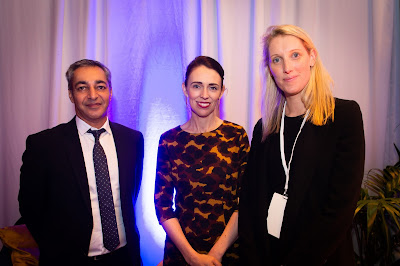The “Stay home, Save lives” Doodle on the Google New Zealand homepage 3-5 April
Overcoming a crisis of this scale will take a sustained effort, and we want to do everything we can to help. Since the virus first began to spread, our focus at Google has been on making sure people have the information and tools they need. We’ve been working with the Government to share public health messages and help them make the most of the free advertising we’ve made available through our Ad Grants programme. But we know there’s much more work ahead.
Today, we’re sharing the actions we’re going to be taking to support New Zealand both in the ongoing short-term response to the virus, and in the long-term, concentrating on three priorities that we believe are critical to a sustainable recovery:
- Supporting education and learning;
- Contributing to business continuity and economic recovery; and
- Promoting authoritative and reliable information.
Supporting education and learning
Around 1.5 million students are out of school in New Zealand, which in turn puts a huge pressure on families, schools and the incredible teachers who nurture our children’s passion for learning.
To help teachers get the support they need to teach remotely, we’ve made tools like Hangouts Meet and Google Classroom available for free, provided training and tips through both Google and YouTube, and launched Teach from Home with UNESCO as a central hub for teachers around the world.
We have also made the premium version of our video conferencing software, called Meet, free to all of our New Zealand and global G-Suite customers until September 2020, to allow large meetings, livestreams and meeting recordings.
We all know the power of great teachers and inspiring lessons, and we hope these steps will help our kids continue to learn for as long as schools remain closed, and return energised when the education system re-opens.
Contributing to business continuity and economic recovery
Small businesses are the heart of our economy and communities and, from small retailers to restaurants, they've been hit hardest by the outbreak.
Last week we launched Google for Small Business, which provides Kiwi small- and medium- sized businesses with helpful advice, resources, and tools, to navigate challenges caused by COVID-19.
We also announced an $800 million commitment to support small businesses, health organizations and governments with access to finance, ad credits and grants to help meet the costs of the virus. Local small businesses can find more information here.
Promoting authoritative and reliable information sources
It's crucial that people have access to health information they can trust online, so they can make the right decisions to protect themselves and those around them from COVID-19. We've surfaced the latest updates and health advice from international health authorities across Search, Maps and YouTube. We've also helped promote hygiene awareness campaigns, shared travel advisories, and shared regular updates on the Search trends we are seeing as Kiwis look for help and information.
We’re working closely with the All of Government team and the Ministry of Health to ensure public health messages are being found by Kiwis wherever they’re searching. These messages have appeared across Google and YouTube to help Kiwis to keep informed. We’re also providing Community Mobility Reports - that analyse aggregate, anonymised location history and provide local insights into the impact of social distancing.
We’ve also stepped up our work to curb misinformation spreading on Google, YouTube or through apps on the Play Store. We have already taken down thousands of YouTube videos featuring dangerous or misleading coronavirus information, and we continue to remove videos that promote medically unproven methods to prevent coronavirus in place of seeking medical treatment.
Reliable information is vital in the fight to slow the virus’ spread and ultimately prepare for economic recovery. We’ll continue working to expand the number of authoritative sources that people can trust, and combat misinformation that can risk people’s health and hold back the global response.
COVID-19 puts intense demands on us all, and we’re determined to do our part in this unprecedented time: to enable access to trusted information, support remote learning, back small businesses, and more. We’re ready to stand with all Kiwis and do all we can to help as we overcome COVID-19 and shape a stronger future.
Post content







